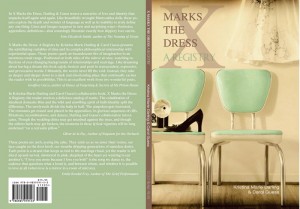
Goldwake Press
102 pages/ $15.95
Review by Carlo Matos
X Marks the Dress, a wonderful and entertaining collaboration between Kristina Marie Darling and Carol Guess, takes the shape of a registry: the marriage, so to speak, of ritual and consumerism; that is, the economic reinforcement of the hetero-normative traditions and social conventions that govern and limit marriage practices. A registry is, of course, first and foremost a collection of things. In previous books, Kristina Marie Darling has explored how the things that remain from failed relationships can bury, bind or enslave the beloved and how those individual items are culturally situated along the lines of gender and power. Darling says in an interview at heavy feather review that she wanted to “defamiliarize many of the objects, rituals and conventions associated with weddings,” and I think Darling and Guess have succeeded in accomplishing that goal without getting too bogged down in polemic.
In Appendix A, there is a footnote that references an “autobiographical novel [that] depicts a heroine’s pursuit of an alternative to marriage, particularly the social conventions governing the ceremony itself.” The authors very plainly play with the notion that marriage means man-and-wife. I have to admit to my great consternation that it was far too easy for me to simply assume that the marriage was between a woman and a man. In fact, it seems to me that the book is calculated to lure the reader into this too-easy assumption in order to, like Ibsen loved to do to his audiences in the nineteenth-century, jar us into recognition. The duo is actually a trio: “I’m tired of threeways where no one gets fucked” (“[Wedding Favor: Coin Purse]”). The male figure is transgender: “I can’t keep my two lives together much longer. Once the M on my license goes missing, our marriage dissolves: two women mean nothing” (“Pearl-handled Letter Opener”). The female character had a secret second wedding: “Darling, you know how my mother and father rejected me? . . . Well, I told my parents I was marrying a man. I hired an actor to play my husband” (“Pizza”). Continue reading
![[PANK]](http://pankmagazine.com/wp-content/themes/pank/assets/images/pank-logo-large.png)
